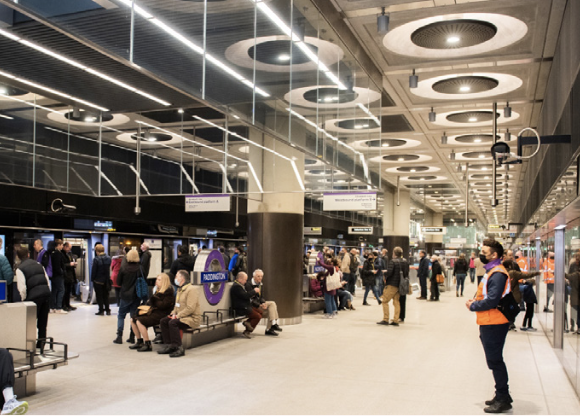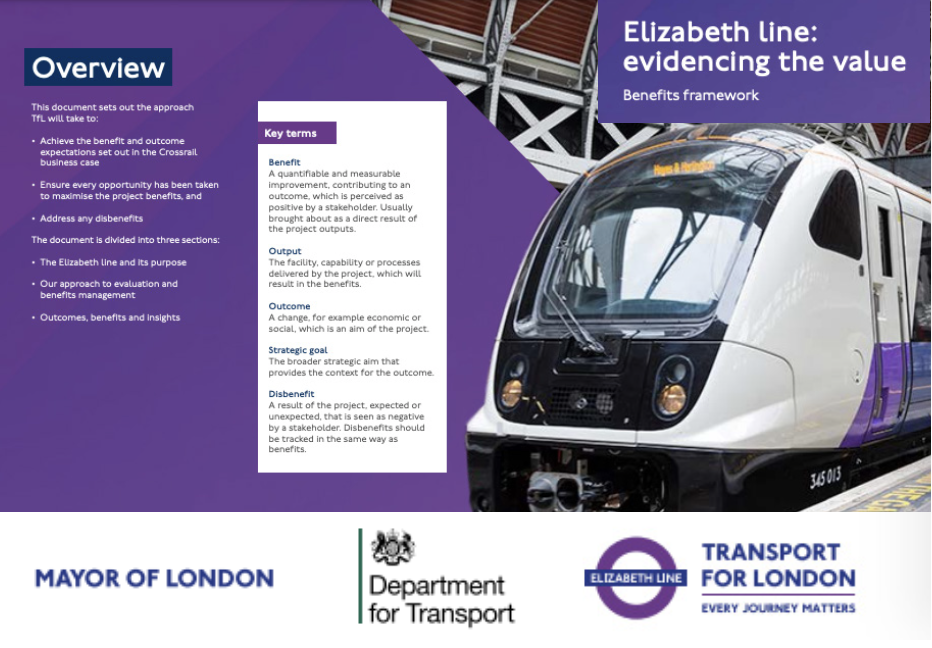TAPAS.network | 1 August 2023 | Examining Evidence | Elizabeth Line
Comprehensive evaluation study provides new transport planning resource
How the Elizabeth line has impacted on the transport system in the capital is being carefully monitored by Transport for London, but its significance in terms of transport planning is wider. looks at the short and long term evaluation framework and the outputs it will deliver.
TfL has put in place a detailed and comprehensive impact study of the Elizabeth line, which is likely to prove of great interest and value to the wider transport planning community.
TfL will draw on a variety of data sources, covering subjects including trip volumes, where passengers have come from and other behavioural issues, crowding, customer satisfaction, passenger journey lengths, trips between selected origin-destination pairs, station usage and interchange (particularly Thameslink connections at Farringdon), the nature of new developments and businesses (from the London Development Database), abstraction from other railways and modes, usage of car and cycle parking spaces at EL stations, generalised journey time, journey purpose, crime, and disabled passengers’ use of the EL and their satisfaction.

The new Paddington station serving the Elizabeth line much increases capacity at this major London interchange
It will also highlight the relationship with what was forecast – and the actual out turn. “This is the biggest test for our models that we’ve ever had,” TfL’s David Warner explains.
The work continues a tradition of high-quality evaluation undertaken by TfL and its predecessors.
“The Victoria line was maybe the first transport scheme to use cost-benefit analysis” Warner observes. “That was in the late 1960s. The Jubilee line extension added about 80 million passengers [per annum] when that opened in 2000 and that was the most recent large scheme. The EL is way bigger than that.”
TfL’s benefits framework document titled, ‘Elizabeth line: evidencing the value’, sets out it will gather evidence for understanding the benefits and outcomes, demonstrate value for money and learn important lessons for the future.
The evaluation involves two strands of work. The initial task has been to create an early picture of how the railway is performing, focusing on actions that can help best capture the scheme’s benefits. The first post-opening evaluation study will be produced after 24 months, focusing on the transport network effects and providing baseline information on wider socio-economic impacts. Arup have been appointed to deliver this. An initial findings report is expected to be published in spring 2024 and a comprehensive report in spring 2025.
The other strand will analyse the wider economic, environmental and social impacts which take longer to emerge, such as mode shift and economic growth. This will examine the return on investment, using actual observations of benefits, five years after opening, and also update the findings on transport impacts from the first post-opening study. These wider economic, social and environmental effects will take longer to emerge and this second study will be commissioned in early 2025.
As part of the project evaluation, work has also started on a review of the Crossrail funding/financing model with an aim to write an objective and factual account of that innovative model. TfL believes the Crossrail story is relevant to other projects in London and the UK and is also much discussed internationally. The work is being carried out by TfL and includes some of the people who have been working on Crossrail funding and financing from 2007. The team will progress the review during the summer and some initial findings have already been produced.
To help answer all the research questions being addressed, the first study will rely on the comprehensive travel data and models held by TfL and the wider travel industry to estimate journey numbers and analyse travel patterns. In addition, a passenger survey will be conducted later this year to collect insights into travel behaviour at key Elizabeth line stations with questions relating to journey purpose, routing and reasons for route choice, frequency of journey, ticket type, use of mobility aids and key demographic characteristics. TfL wants to use mobile network data that offers the opportunity to fill data gaps to better analyse road use and estimate the shift to public transport.
How useful will the Elizabeth line’s post-opening evaluation be to promoters of future rail projects? Warner thinks the Crossrail 2 scheme, now mothballed, may be revisited in the future and provides an opportunity for the lessons to be passed on. He also points to smaller schemes, such as orbital rail in North-west London and extending the DLR to Thamesmead. “It’s increasing our understanding should other projects come along. We now have a good chance to validate the forecasts with a big scheme, as opposed to a small one.”
There will doubtless be other major regionally-significant rail projects that can benefit from the knowledge too. Northern Powerhouse Rail, East-West Rail and the South Wales Metro are some that spring to mind.

TfL last year published an impressive document setting out how it would work with the Department for Transport to examine the emerging outcomes from the Elizabeth line’s impact.
Elizabeth line: evidencing the value

Peter Stonham is the Editorial Director of TAPAS Network
You are currently viewing this page as TAPAS Taster user.
To read and make comments on this article you need to register for free as TAPAS Select user and log in.

Log in